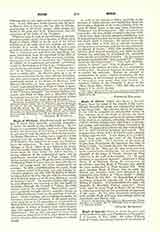

Hugh of Flavigny, Benedictine monk and historian; b. about 1064, probably at Verdun (Lorraine); d. before the middle of the twelfth century. He belonged to a prominent family, and received his education at the monastery of St-Vannes at Verdun, where he afterwards took the habit of a Benedictine novice. As Bishop Dietrich of Verdun was a supporter of the emperor and his antipope, Clement III, the Abbot of St-Vannes, who supported the pope, was forced to leave his monastery. He went to the Abbey of St-Benigne at Dijon, where he was followed by nearly all of his monks, including Hugh. While at Dijon the latter made his vows before the Abbot Jarento, a strong adherent of the ecclesiastical party and an enthusiastic personal friend of Pope Gregory VII. Abbot Jarento soon gave Hugh his entire confidence; Archbishop Hugh of Lyons was also most friendly towards the young monk and often requisitioned his services. In 1096, notwithstanding his youth, Hugh was elected Abbot of Flavigny, but soon became involved in disputes, not only with the Bishop of Autun, in whose diocese he was, but also with his own monks, who wished to make use of all, even dishonest, means in the pope’s behalf. On account of these differences, he was obliged on two occasions to flee, and finally to abdicate, although the Council of Valence (in 1100) ordered him to be reinstated. These bitter experiences gradually brought about a complete change in his politico-religious views on the question of investitures. From a zealous, self-sacrificing champion, he became a determined adversary of the papal claims, even going so far in his opposition as to accept from Bishop Richard of Verdun, a follower of the emperor, the dignity of Abbot of Verdun, after Abbot Laurentius, who supported the pope, had been quite illegally dispossessed. But he only succeeded in maintaining this position from 1111 to 1114, after which he seems to have lived in strict seclusion at Verdun as a simple monk.
As early as his sojourn at Dijon, probably at the instance of Abbot Jarento and Archbishop Hugh, he had begun a chronicle of the world’s history from the birth of Christ down to his own times (Chronicon Virdunense seu Flaviniacense). This we possess in two books: the first, which extends to the year 1002, is little more than a loosely planned compilation, and its importance is entirely due to the fragments of older lost works which it contains; the second covers the years from 1002 to 1112 and is valuable especially for the history of Lorraine, and also for the ecclesiastical history of France. With wide erudition he collected a great mass of materials, and, where his facts became too unwieldy, he abandoned the annalistic form for full and detailed narrative. In this manner he brings out in relief the “Acta Gregorii VII”; “Series Abbatum Flaviniacensium”; “Vita beati Richardi, abbatis S. Vitori”, and “Vita S. Magdalvei”. His account of the election of Victor III is a masterpiece for his period. In general, however, he cannot be said to control his materials. Making no attempt at arrangement, he quotes original documents, his own experiences, or the testimony of others, to whose tales he often gives more credit than they deserve. A complete edition of the Chronicle is given in the “Mon. Germ. Hist.: Script.”, VIII, 288-502, and in Migne’s P.L—CLIV, 21-404.
PATRICIUS SCHLAGER

